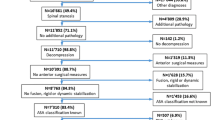Abstract
Purpose
The purpose of this study was to report the incidence of dural tear (DT) in spine surgery, risk factors, and patient outcomes on a national level.
Methods
Clinical data were obtained from the Nationwide Inpatient Sample for 2009. Patients who underwent spine surgery were identified and, among them, patients who had DT were identified, according to the International Classification of Diseases, 9th revision, Clinical Modification (ICD-9-CM) codes. Patient and hospital demographic data were retrieved. The incidence of DT and in-hospital patient outcomes were analyzed. Multivariate logistic regression analysis was performed to identify the risk factors for DT.
Results
The incidence of DT was 2.7 % (17,932/665,818). Multivariate analysis revealed that older age, female gender, increased Elixhauser comorbidity score, and high hospital caseload were the significant risk factors for DT. Comparison between patients with and without DT showed that those with DT had significantly higher overall in-hospital complications (18.8 vs. 10.2 %), higher in-hospital mortality rate (0.4 vs. 0.3 %), longer hospital stays (5.1 vs. 3.7 days), lower proportion discharged home routinely (61.0 vs. 76.8 %), and increased total hospital charges ($85,138 vs. $71,808), respectively.
Conclusions
The reported incidence of DT in spine surgery was 2.7 % in the US. Risk factors included older age, female gender, increased comorbidities, and high hospital caseload. DT increased the rate of in-hospital complications and mortality and health care burdens.
Similar content being viewed by others
References
Williams BJ, Sansur CA, Smith JS et al (2011) Incidence of unintended durotomy in spine surgery based on 108,478 cases. Neurosurgery 68:117–123
Baker GA, Cizik AM, Bransford RJ, Bellabarba C, Konodi MA, Chapman JR, Lee MJ (2012) Risk factors for unintended durotomy during spine surgery: a multivariate analysis. Spine J 12:121–126
McMahon P, Dididze M, Levi AD (2012) Incidental durotomy after spinal surgery: a prospective study in an academic institution. J Neurosurg Spine 17:30–36
Cammisa FP Jr, Girardi FP, Sangani PK, Parvataneni HK, Cadag S, Sandhu HS (2000) Incidental durotomy in spine surgery. Spine 25:2663–2667
Guerin P, El Fegoun AB, Obeid I, Gille O, Lelong L, Luc S, Bourghli A, Cursolle JC, Pointillart V, Vital JM (2012) Incidental durotomy during spine surgery: incidence, management and complications. A retrospective review. Injury 43:397–401
Ruban D, O’Toole JE (2011) Management of incidental durotomy in minimally invasive spine surgery. Neurosurg Focus 31:E15
Sin AH, Caldito G, Smith D, Rashidi M, Willis B, Nanda A (2006) Predictive factors for dural tear and cerebrospinal fluid leakage in patients undergoing lumbar surgery. J Neurosurg Spine 5:224–227
Strömqvist F, Jönsson B, Strömqvist B, Swedish Society of Spinal Surgeons (2012) Dural lesions in decompression for lumbar spinal stenosis: incidence, risk factors and effect on outcome. Eur Spine J 21:825–828
Takahashi Y, Sato T, Hyodo H, Kawamata T, Takahashi E, Miyatake N, Tokunaga M (2013) Incidental durotomy during lumbar spine surgery: risk factors and anatomic locations: clinical article. J Neurosurg Spine 18:165–169
Hannallah D, Lee J, Khan M, Donaldson WF, Kang JD (2008) Cerebrospinal fluid leaks following cervical spine surgery. J Bone Joint Surg Am 90:1101–1105
Wiese M, Krämer J, Bernsmann K, Ernst Willburger R (2004) The related outcome and complication rate in primary lumbar microscopic disc surgery depending on the surgeon’s experience: comparative studies. Spine J 4:550–556
Pechlivanis I, Kuebler M, Harders A, Schmieder K (2009) Perioperative complication rate of lumbar disc microsurgery depending on the surgeon’s level of training. Cen Eur Neurosurg 70:137–142
Bosacco SJ, Gardner MJ, Guille JT (2001) Evaluation and treatment of dural tears in lumbar spine surgery. Clin Orthop 389:238–247
Mayfield FH, Kurokawa K (1975) Watertight closure of spinal dura mater: technical note. J Neurosurg 43:639–640
Mokri B (1999) Spontaneous cerebrospinal fluid leaks: from intracranial hypotension to cerebrospinal fluid hypovolemia—evolution of a concept. Mayo Clin Proc 74:1113–1123
Wang JC, Bohlman HH, Riew DK (1998) Dural tears secondary to operations on the lumbar spine: management and results after a two-year-minimum follow-up of eighty-eight patients. J Bone Joint Surg Am 80:1728–1732
Eismont FJ, Wiesel SW, Rothman RH (1981) Treatment of dural tears associated with spinal surgery. J Bone Joint Surg Am 63:1132–1136
Jones AAM, Stambough JL, Balderston RA, Rothman RH, Booth RE Jr (1989) Long-term results of lumbar spine surgery complicated by unintended incidental durotomy. Spine 14:443–446
Kitchel SH, Eismont FJ, Green BA (1989) Closed subarachnoid drainage for management of cerebrospinal fluid leakage after an operation on the spine. J Bone Joint Surg Am 71:984–987
Healthcare Cost and Utilization Project (HCUP) (2004) Agency for Health-care Research and Quality. Available at: http://www.hcup-us.ahrq.gov/nisoverview.jsp. Last Accessed 1 Mar 2013
Elixhauser A, Steiner C, Harris DR, Coffey RM (1998) Comorbidity measures for use with administrative data. Med Care 36(1):8–27
Espiritu MT, Rhyne A, Darden BV 2nd (2010) Dural tears in spine surgery. J Am Acad Orthop Surg 18:537–545
Ahn Y, Lee HY, Lee SH, Lee JH (2011) Dural tears in percutaneous endoscopic lumbar discectomy. Eur Spine J 20(1):58–64
Radcliff KE, Sidhu GD, Kepler CK, Gruskay J, Anderson DG, Hilibrand A, Albert TJ, Vaccaro AR (2012) Complications of Flat Bedrest Following Incidental Dural Repair. J Spinal Disord Tech (epub ahead of print)
Conflict of interest
None.
Author information
Authors and Affiliations
Corresponding author
Rights and permissions
About this article
Cite this article
Yoshihara, H., Yoneoka, D. Incidental dural tear in spine surgery: analysis of a nationwide database. Eur Spine J 23, 389–394 (2014). https://doi.org/10.1007/s00586-013-3091-z
Received:
Revised:
Accepted:
Published:
Issue Date:
DOI: https://doi.org/10.1007/s00586-013-3091-z



